
In Lightspeed’s 2024 State of Retail report, we take a look into the preferences of different age groups, like Generation Z shopping habits compared to older generations and where customers are going for product information.
Our findings reveal a significant shift in how younger shoppers interact with brands, and affirm the continuing relevance of brick and mortar stores across all age demographics.
Retailers looking to succeed across age brackets will need to take a multi-faceted approach—there are few places where everyone agrees.
Let’s dive in.
- How buyers engage with a brand varies by age
- Older buyers go to the source
- Middle-aged buyers prefer critical reviews
- Younger buyers are on viral content platforms
- How age impacts desired value
- Gen Z’s shopping habits
- Instant restocks
- Retail subscriptions
- VIP services
- The pulse on brick and mortar
- Who’s winning offline
- Where the shop local energy has gone
Consumer behavior by generation: How buyers engage with a brand varies by age
Finding new buyers for a new brand or product has never been more complex. Markets are saturated, as are communication channels. Cutting through the noise can be difficult.
Our research indicates that the ideal strategy is multi-faceted thanks to the way age impacts where customers are looking to connect with brands, and why.
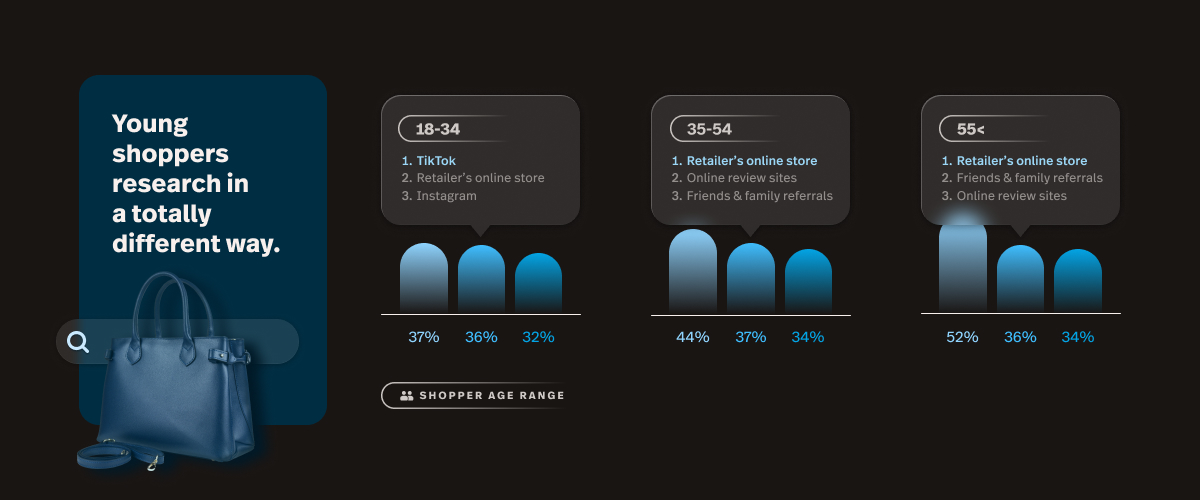
There is one area where every generation agrees: the importance of brick and mortar—more on that later.
But when it comes to shopping online, researching purchases and checking up on brands, different generations are looking for different things; a one-size-fits-all approach won’t cut it.
Gen X, Boomers and older
Shoppers above 55—the oldest members of Gen X, along with Boomers and older generations—like to go directly to the source when they’re in the consideration phase. They value information from their immediate community and what retailers put out into the world.
Their top three chosen sources of information break down as such:
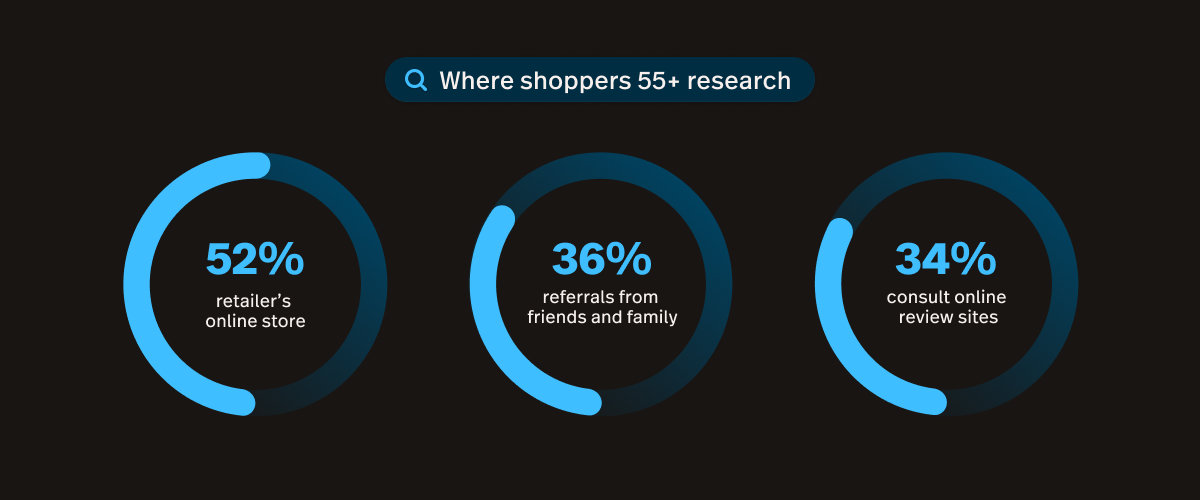
- 52% will do research using a retailer’s online store
- 36% will look for referrals from friends and family
- 34% consult online review sites
Older shoppers consult social media the least. Only 2% look to TikTok or Instagram for product information. If they do check social media while researching, it’s most likely to be Facebook—but we still found only 11% of them bother to look there.
Millennials and Xillennials
In the 35 to 54 range—most Millennials and younger members of Gen X, also known as Xillennials—we see a slight shuffling of priorities. While they still value what retailers are saying above other information sources, they’re slightly more interested in critical breakdowns than the informal opinions of their community.
Specifically, when they’re researching purchases:
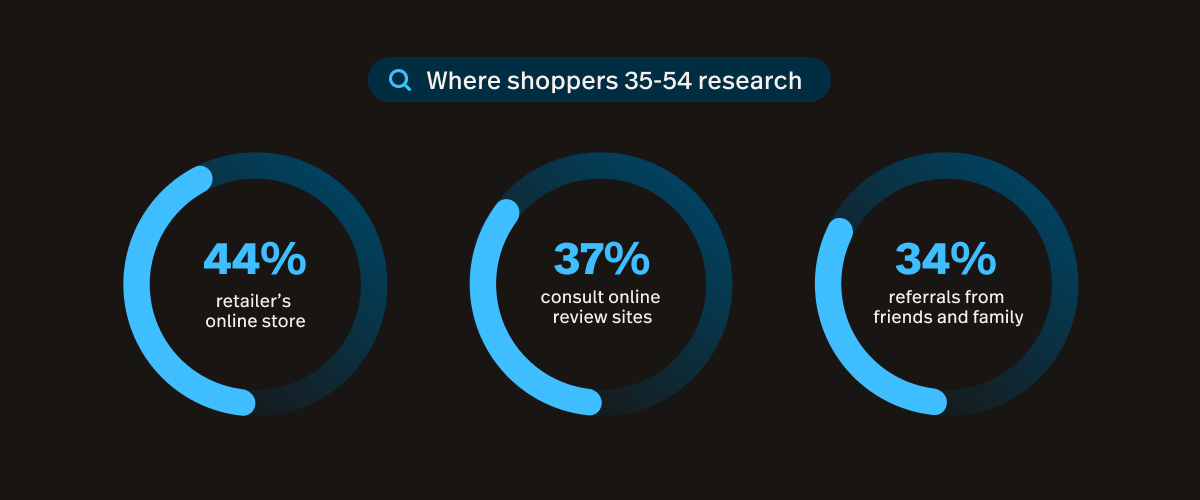
- 44% rely on a retailer’s online store to give them the information they need
- 37% consult review sites for critical details
- 34% ask their friends and family for referrals
Compared to older shoppers, Facebook (20%) and Instagram (16%) play a more pronounced role in this demographic, suggesting that they use a mixture of online sources to determine what to buy.
Other social media doesn’t do as well. Only 7% of Millennials and Xillennials are using Pinterest to research products, while TikTok only catches the eye of 11% of them.
Gen Z and Zillennials
Younger shoppers have an entirely different shopping dynamic when compared to their older peers. The 18 to 34 cohort—Gen Z and Millennials on the cusp, or Zillennials—aren’t primarily consulting their friends and family offline or seeking out review sites like older shoppers.
In fact, they’re less united as a whole. While nearly half of shoppers between 35 and 54, and over half of shoppers above 55, agree on the importance of a retailer’s online store for their research, no single method reaches that much saturation for the younger crowd.
One thing is clear, though: they’re far more interested in viral content. Their top sources for pre-purchase information break down like this:
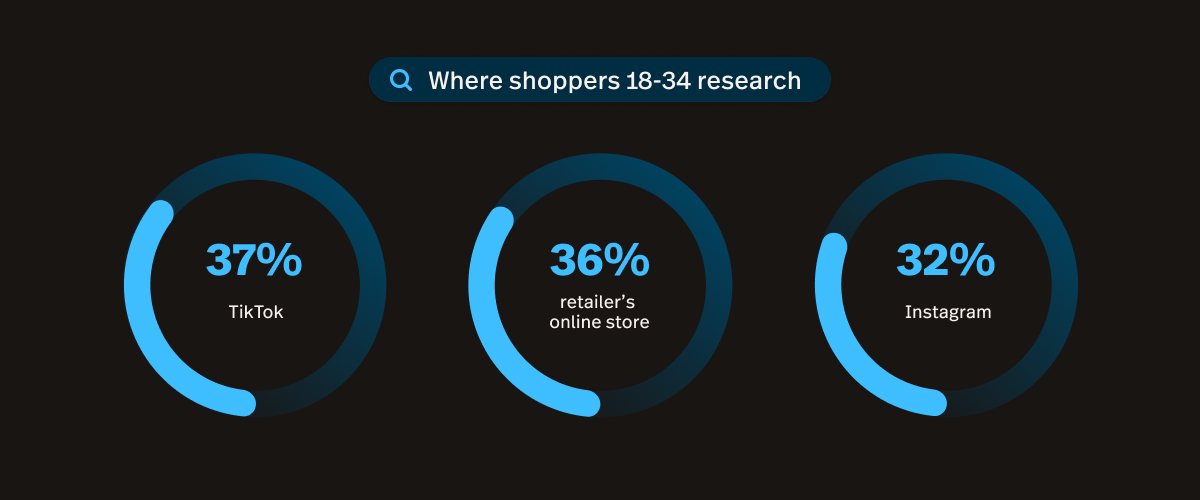
- 37% take to TikTok for product research and information
- 36% look at a retailer’s online store
- 32% check Instagram
Even with their preference for social media, it appears the value of influencers is not as important as you might expect. Only 12% of the younger age bracket said specific influencers played a role in their buying decisions, which puts them in line with their older peers (6% of the middle bracket and a meager 1% of the 55+ demographic). This would imply they’re looking for content by brands and viral trends when they’re on social media.
Everyone is looking for a deal
In this tight economic environment, shoppers are on the hunt for a bargain. No matter their age, customers want the best value for their dollars.
Free shipping and special deals are important for all generations, with 54% of all survey respondents saying it’d encourage them to buy more.
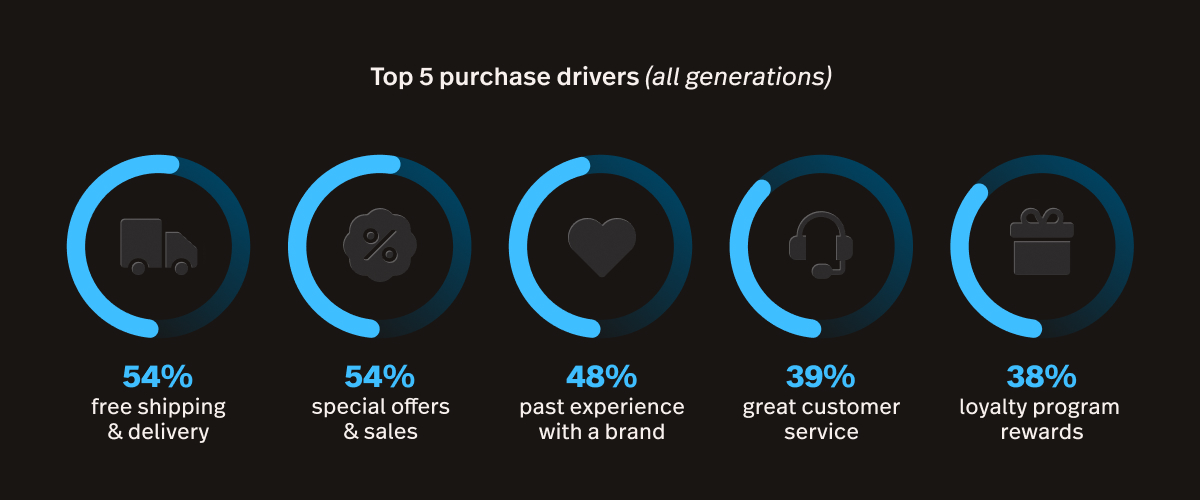
But when we break shoppers down into their generations, we see priorities shuffling by age. Gen Z and Millennials rate free shipping as the most important factor for spending more, but deals and discounts are the primary driver for shoppers over 55, with 61% of those respondents rating them as the most important. In fact, older respondents rate past experience with a brand as slightly more important than free shipping.
That’s not the only way the generations differ.
- The older generations are the least likely to care about personalized recommendations—only 7% said it would encourage them to shop more
- Millennials care slightly more about a good loyalty program (40%) than Gen Z (35%)
- Gen Z is most likely to care about sustainable products—but still only 22% of them say it’d encourage them to buy more
Key takeaways
While the middle and older age cohorts vary slightly, there’s a sharp divide between how they interact with brands and how your younger customers do.
Take your site seriously… but don’t leave social media behind: every cohort of shoppers has their own quirks, but they all rely on a retailer’s site to some degree. Your site should be easy to navigate, SEO optimized and up to date, with detailed product information (including materials, dimensions and manufacturing process) and reviews.
- At the same time, you should be connecting to your ideal customer on their platform of choice: Facebook for Millennials, TikTok for Gen Z and Instagram all around. Consider using an ecommerce platform that makes advertising and selling on multiple platforms simple.
Start seeing your online presence as an always-on marketing campaign: you’re not just selling online. You’re educating customers. No matter where they land, they should be able to get a full picture of who you are, what you sell and what your value proposition is. That means, for example, if you’re targeting a younger crowd, keeping up a TikTok presence is as important as selling on Amazon.
Switch away from influencers and more towards influencing word of mouth: if you’ve ever invested in influencers, it might be time to redirect that budget.
- Keep your ideal customer demographic in mind—a referral program is likely to perform well for older and middle-aged shoppers, but Gen Z will need to be influenced to speak out on TikTok and Instagram. Is your unboxing experience exciting enough to do numbers with that crowd?
Let’s drill down into Generation Z shopping habits
Finding and interacting with brands through social platforms like TikTok and Instagram are not the only difference in how Gen Z (and younger Millennials) approaches retail shopping.
In some regards, they are significantly different in their approach to retail all together.
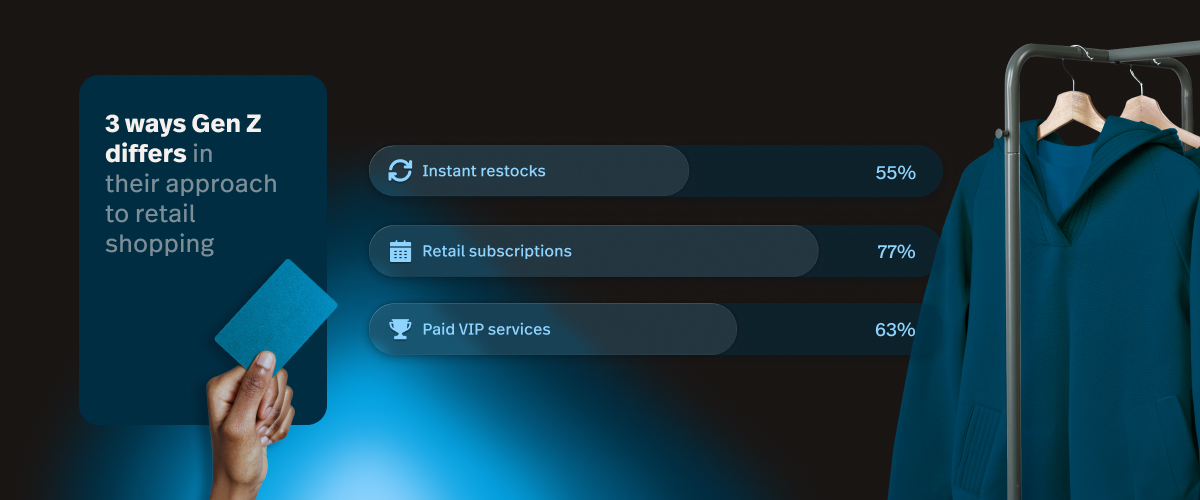
Instant restocks? Worth the cost
No one likes empty shelves and out of stock messages. But younger shoppers don’t see them as an insurmountable barrier; 55% of shoppers aged 18 to 34 say that they would pay more than the sticker price to have that item immediately available to them from another source.
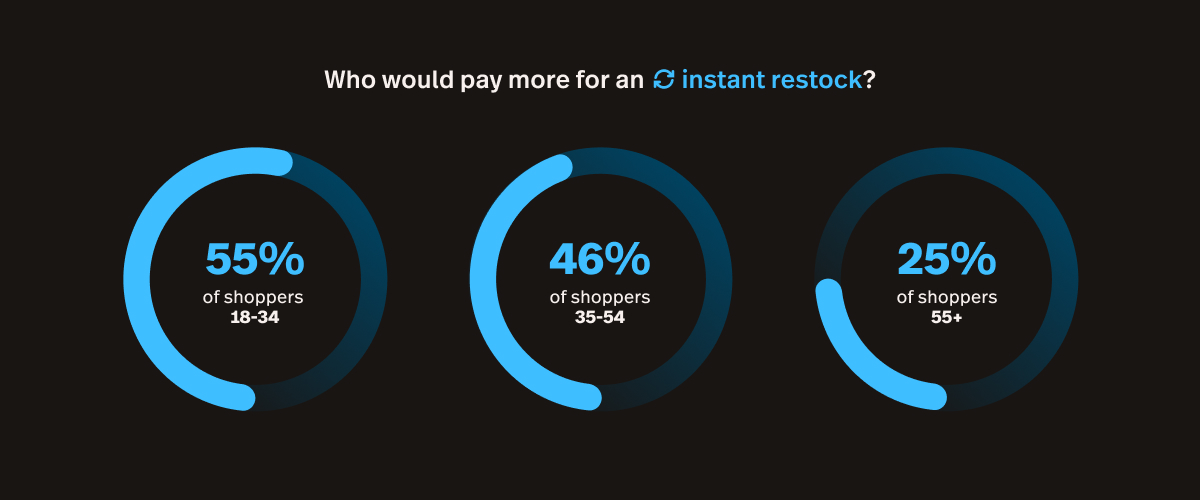
All other age demographics would wait for that item to be restocked, with only 36% of shoppers 35 and older willing to pay more for an instant restock—and the older they are, the less likely they’d pay.
Subscriptions abound
In our findings, Gen Z was the demographic most likely to be subscribed to a retail membership (like Amazon Prime), with 77% saying they were subscribed to one or more services. 19% said they exclusively shop with retailers they have subscriptions with. This implies that their relationships with retailers aren’t just about products.
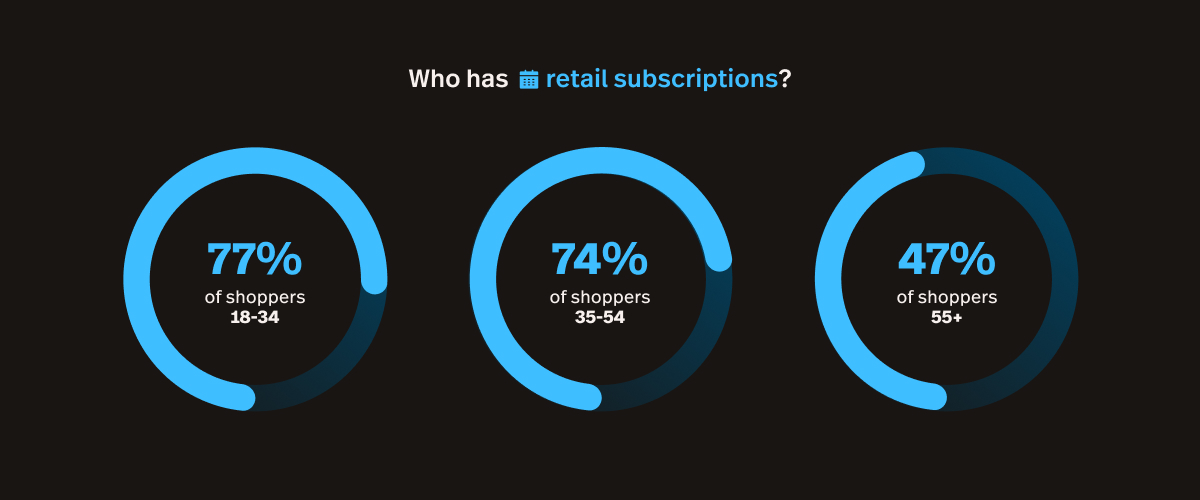
The older a shopper is, the less likely they are to agree with Gen Z; 43% of Boomers and older have no retail subscriptions, and only 11% of those that do exclusively shop with their subscribed brands.
Special service
Building on the idea that Gen Z goes to retailers for more than products, younger shoppers were the most interested in the idea of a VIP service, with potential benefits like skipping lines, personalized shopping recommendations or early access to products. 42% of those we surveyed said they’d definitely be intrigued, with an additional 21% saying they might be into it.
As for how much they’d pay?
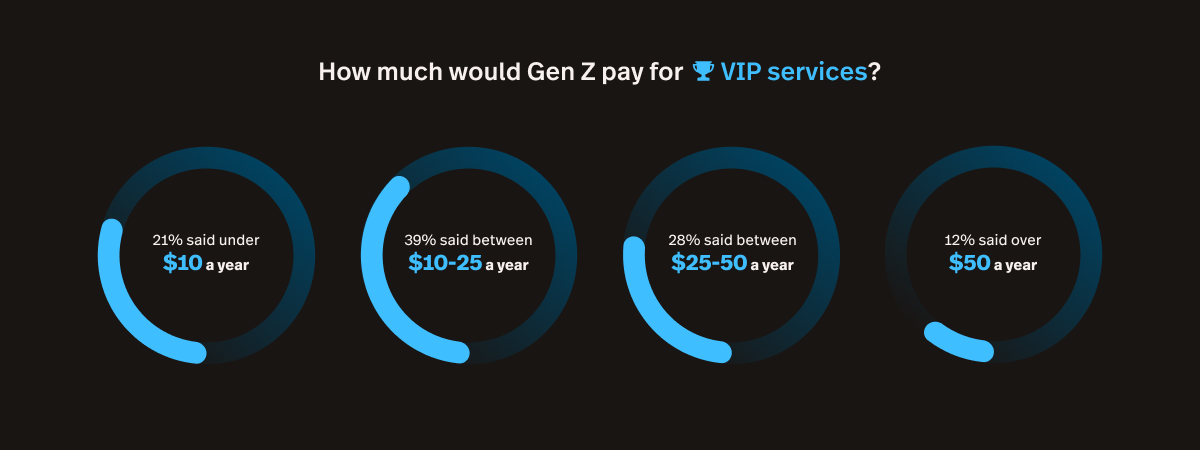
- 21% said under $10 a year
- 39% said they’d pay between $10-$25 annually
- 28% said between $25-$50 annually
- 12% said over $50 a year
In comparison, only 13% of shoppers above 55 and 29% of shoppers between 35 and 54 were interested in a paid VIP service, indicating this is where Gen Z differs the most from their older counterparts.
Key takeaways
How do you speak to Gen Z?
Get ahead of competitors: when you’re out of stock, you’re at risk of losing younger shoppers to competitors faster than their older counterparts, even if you charge less. Restock notifications might not be enough for Gen Z. Give them a way to pre order products you’re low on so you still make the sale.
- Plus, keeping your shelves fully stocked helps you avoid this dilemma in the first place. Use a data reporting tool like Lightspeed Insights to ensure every order is optimized and you’re less likely to be out of stock in what they want.
Join them to beat them: subscriptions to retail services like Amazon Prime are so common with Gen Z that there’s no point in trying to beat them. You’re better off optimizing how you advertise and sell on the most popular retail subscription marketplaces (like Amazon and Walmart) so your products are still in front of your younger customers.
Points aren’t enough anymore: a free to join, points-based loyalty program is enough to make older shoppers feel appreciated, but Gen Z is interested in paying for even more personalized service. If young shoppers are an important part of your customer base, consider how you can implement paid VIP tiers with perks beyond points and cash back.
The great uniter: brick and mortar plays an important role in shopping for everyone
No matter the generation, every age group we surveyed agreed on the topic of brick and mortar—namely, that in-person shopping is still an important part of the buying journey.
Long gone are the doom and gloom days of brick and mortar. Predictions that online shopping would end traditional in-store experiences have proven to be false. While online shopping does play an important role in how buyers interact with brands, brick and mortar locations have seen a resurgence in their importance overall.
More than half of shoppers of all ages reported doing most of their shopping in stores. There was very little variation across ages, gender or income level. In fact, the only true differentiator seems to be nationality—55% of US shoppers do most of their shopping in person, while that number jumps to 64% for Canadians.
Let’s break it down by category
While there’s only one category where shoppers prefer to buy online, the preference for in-store shopping is stronger in some categories.
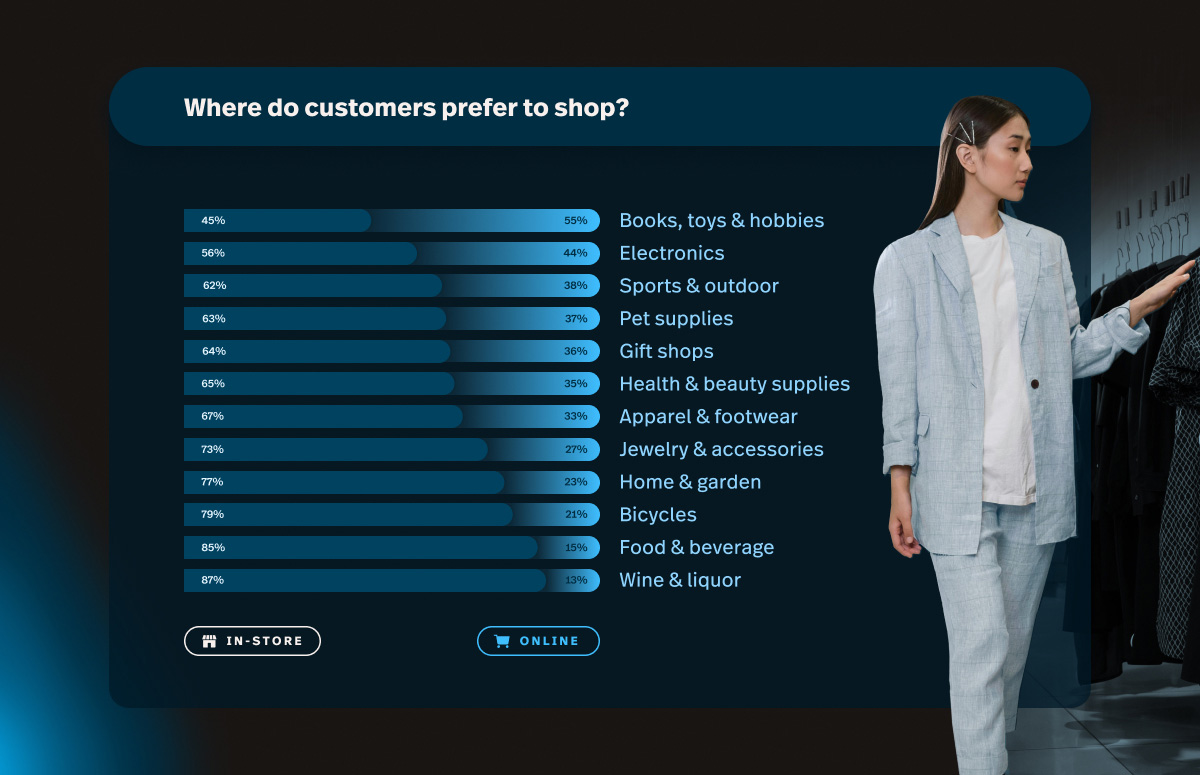
Food and beverage top the list, along with alcohol sales; shoppers strongly prefer buying these perishable goods in person, likely so they can check for quality. Bicycles and home and garden goods also show a clear preference for an in-person purchase, possibly thanks to shipping logistics (or a desire to test the product).
Meanwhile, books, toys and hobbies reign supreme for online shopping. This is no surprise—Amazon first made headway as a bookstore, after all. Shoppers are simply used to buying books online in a way other categories haven’t broken through to.
Shop local… sometimes
Category plays an important role in consumer preferences for shopping local brick and mortar businesses.
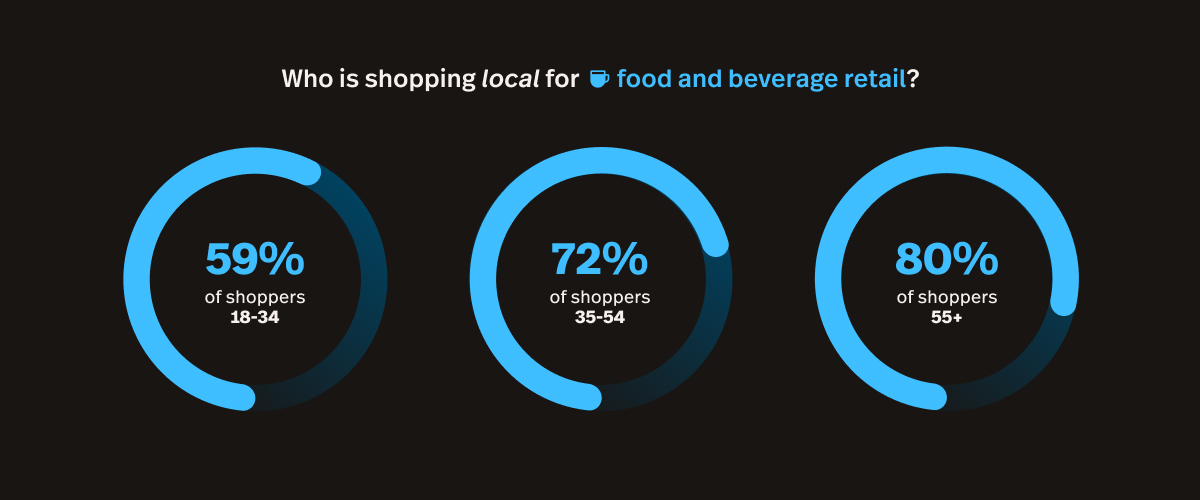
74% of respondents agreed that shopping local was important to them, but when asked about which sectors they would most likely shop local, we see efforts are concentrated in a few key areas.
- 71% of shoppers across age groups cite food and beverage as their number one priority for shopping local
- Shoppers over 55 show the strongest affinity for shopping local food and beverage retail (80%), while the youngest shoppers are less motivated (59%)
- Home and garden and wine and liquor come in a far second at 41% each
- Just over a third (31%) of respondents said they’d prioritize local apparel brands
- When asked what the most important factors in deciding on apparel purchases are, the option of locally made goods was far out weighted by affordability (72%) and quality (65%)
Key takeaways
This is no time to rest on your brick and mortar laurels.
Let us again consider books: people preferred buying them in person until they didn’t, and booksellers who couldn’t adapt went under. Today, the book buying landscape is almost entirely online.
Offer an impressive in-store experience: if customers get frustrated, they’ll head to a competitor. Do your employees have the tech and tools they need to make visiting your business a frictionless experience? Take a good look at your tech stack—do you need to upgrade your POS? How fast are your payments? Can you take special orders when a shelf is empty?
Give customers a seamless way to go from online to offline: significant amounts of shoppers across all age categories are starting their research online. And yet they’re still reporting a preference for offline shopping—that means you need to be sure you’re bridging the gap.
- Go beyond BOPIS. Is your loyalty program multi-channel? Can in-store employees check a customer’s online purchase history to tailor recommendations? Or are you making your customers do the legwork when they’re ready to buy?
Keep your category in mind: food and beverage retailers face less immediate threat from ecommerce competitors and channel cannibalization than electronics retailers, so should look more towards what their offline competitors are planning. Electronics retailers need to be focusing on the seamless online-to-offline purchase journey, as the affinity for buying in person is less strong there. Nearly everyone else falls somewhere in the middle of these categories and should keep that in mind when planning business operations.
- Bookstores, meanwhile, need to beef up their online presence and try to coax customers back in store with events (or potentially paid VIP experiences—hello, Gen Z).
In summary
Lightspeed’s 2024 State of Retail report underscores the varied shopping preferences across generations, particularly highlighting how Gen Z’s approach differs from older groups.
Our findings emphasize the enduring appeal of brick and mortar stores alongside emerging trends. For retailers aiming to remain competitive, grasping these nuances is essential.
By tailoring experiences to meet the specific needs of each age group, businesses can boost engagement and foster growth.
Lightspeed offers future-proof POS technology and top-tier retail insights to help retailers accelerate their operations, remain flexible and respond to evolving consumer trends. We are the trusted technology partner for some of the top retail businesses globally.
Interested in discovering what Lightspeed can do for you? Watch a demo here.
Methodology
Lightspeed initiated a consumer survey throughout July 2024 using third party survey vendor Medallia. Over 2,500 responses were collected amongst Canada and the United States. Respondents were required to be over the age of 18, and have purchased retail goods within the past six months. All responses collected were anonymous.

News you care about. Tips you can use.
Everything your business needs to grow, delivered straight to your inbox.




